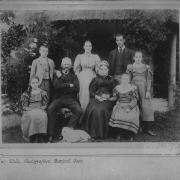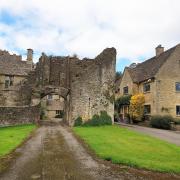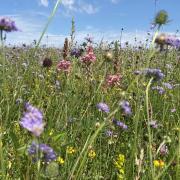My tour of Jamie’s Farm, Bath, is full of the sights and sounds of purposeful activity: young people working in the organic garden beside an outdoor kitchen; cows, pigs, chickens and geese being tended; Minnie the horse enjoying a good grooming. Piles of chopped firewood await use in the biomass boiler that provides the farm with hot water; another area features a tree-house, washroom facilities and fire-pit; all around, the hills rise up giving a sense of the farm being a self-contained world away from other daily hubbub.
The typical reaction of children arriving at the farm is, ‘Oh, this stinks, and they look at all the mud,’ says Tish Feilden, co-founder of Jamie’s Farm with her son, the eponymous Jamie. ‘But we give the children boots and farming suits, and their view changes; they are so curious about things.’ Soon they are describing things as: adventurous, fun and inspiring.
Farmer Jamie and Tish, a psychotherapist, founded Jamie’s Farm charity in 2009, opening its first farm, at Bath, in 2010. The idea had come several years earlier after Jamie, then a teacher in a challenging South London school, took in two sheep from his Bath family home for pupils to care for. Students embraced the responsibility and their attitude towards school life also noticeably improved.
Jamie and Tish developed residential farm programmes for young people who, for differing reasons, are struggling. Experiences offer a catalyst for change, enabling children to thrive educationally, socially and emotionally.
There are now six farms open around the country, and a seventh, on land neighbouring Jamie’s Farm, Bath, is set to open in 2024: bringing Jamie’s Farm in the Cotswolds to 400 acres, with up to 1,000 sheep and 120 pedigree Aberdeen Angus cows. The new farm will add potential for another 450 stays by children a year.

LIFE-SWAP
The charity has already supported over 13,000 children at its farms across the country, with impressive outcomes – improved mental wellbeing and engagement at school, reduced numbers of exclusions, better communication skills. Lots of facts and figures that measure the success and rigour of the Jamie’s Farm approach can be found on the charity’s website.
But essentially this is a story about individuals and how, given the right support and environment, they have the chance to re-imagine themselves and change the narrative of their lives.
Jamie’s Farm, Bath, hosts young people, mainly of secondary school age, from London and surrounding urban areas. Struggles with mental health are on the rise, with causes ranging from repercussions of Covid lockdowns to pressures of the digital world. ‘Children are saturated with negative messages – wars, the environment, the economy,’ Tish says. ‘They can lose their connection to hope and confidence in themselves.’
For most groups – up to a dozen individuals, accompanied by two or three members of staff from their school or organisation – it is their first real taste of the countryside. Mobile phones have to be left behind, which at first causes irritation.
‘But they quickly find it a massive relief because they are no longer connected to the things that are causing them stress, whether that’s being young carers at home or involvement with drugs and gangs,’ Jamie says. Children comment on finding time and space to clear their minds and reflect on their lives.
The five-day residential ‘life-swap’ is built around three core elements: farming, family and therapeutic support, with a fourth, legacy element, continuing after the children’s stay: to sustain positive changes when back at school and home.

The children feed the animals before they have their own breakfast, and then get stuck into tasks necessary to run the working farm: harvesting fruit, collecting eggs, chopping logs, moving sheep, helping at lambing – the latter described by one visitor as ‘one of the best things I’ve done’. Produce is used on the farm or sold locally.
‘We farm regeneratively, which fits well with our philosophy of long-term regeneration of people,’ Jamie says. ‘Growing food and looking after animals is a primal instinct, and there is also excitement and an element of risk, which we manage: perhaps dealing with an escaped animal. It can be tiring and the children get huge satisfaction in seeing their achievements.’
The ‘family’ element of stays on the farm focuses on building healthy relationships in a safe space: working together, cooking and sharing tasty, nutritious meals around one table, helping each other, playing games together – all encourage more positive relationships with peers and adults. Daily walks provide exercise and shared adventure. Years later children, now adults, have said they have built their model of being a family from experiences at Jamie’s Farm.
Therapeutic support is subtly woven into farm life: the children check in with each other at mealtimes, talk about issues in their lives in small groups, and informally one-to-one with a therapy coordinator, learning to vocalise rather than act out their challenges. Work with horses is also influential, these powerful, sensitive animals acting like a mirror, Tish says:
‘If the child is shouty or flighty, the horse doesn’t want a relationship. When the child is calm, they see the horse respond to them physically. It is a beautiful way for a child to arrive at a harmonious relationship.’
Teachers who come to the farm learn a lot, too, and see their pupils in a fresh light, which can be built on back at school – encouraged by follow-up ‘legacy’ work between the farm and schools. A Cultivating Change platform of resources for teachers is also being developed.
Young people feed-back views to Jamie’s Farm through a youth voice initiative, while an apprenticeship scheme offers opportunities to work on a Jamie’s Farm while pursuing a qualification in related fields like farming or outdoor education.

SHARING THE COTSWOLDS
Generating funds is a constant challenge. Currently around 45% of the charity’s income is earned: from its programme with young people, farming and lets – when groups aren’t visiting, people can rent the Bath farmhouse (sleeps 15) or barn and apartment (sleeps 9) via Airbnb.
Around 55% of income is from charitable donations: ranging from trusts and companies to generous individuals, and including fundraiser events like Bath Half Marathon (this year 17 March); Jamie has run it no fewer than 15 times.
Defra ‘removing barriers’ funding, administered by Cotswolds National Landscape (CNL), recently contributed towards the farm’s tree-house/activity hub.
Donations and support are always welcome, and this year there is much work to do to get the new farm at Lower Shockerwick ready to open. Additionally, it is hoped to apply via CNL for Farming in Protected Landscapes programme funding to put towards restoring ancient orchards and ancient ponds there.
Jamie, who won an award for Outstanding Contribution to British Agriculture at the British Farming Awards in 2020, says: ‘I’m Cotswolds born and bred, and I can’t think of a more beautiful place to be. It is wonderful to share it with the children who come here.’ For the children it can be, in their own words: ‘life-changing’.
Find out more about Jamie’s Farm, Bath at jamiesfarm.org.uk





















![Latenightpass with Gina Andrews [left] wins the Cross Country Chase at Cheltenham, December 15, 2023. Photo: Steve Davies/SDphotos.co.uk](/resources/images/128x89/1x/17621852.jpg)
![Latenightpass with Gina Andrews [left] wins the Cross Country Chase at Cheltenham, December 15, 2023. Photo: Steve Davies/SDphotos.co.uk](/resources/images/180x180/1x/17621852.jpg)




